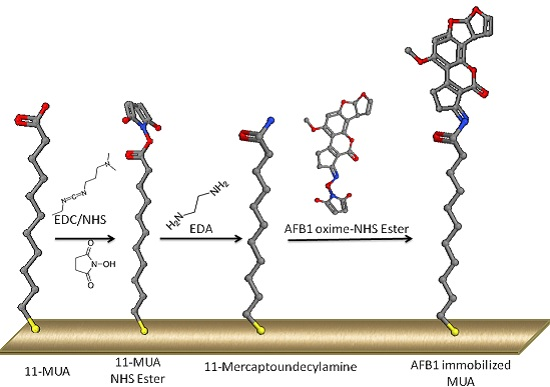Label Free QCM Immunobiosensor for AFB1 Detection Using Monoclonal IgA Antibody as Recognition Element
Abstract
:1. Introduction
2. Materials and Methods
2.1. Materials
2.2. Preparation of the Gold Surface for AF Binding
2.3. Chemical Blocking of Activated Surfaces
2.4. AFB1 Immobilization to the Quartz Crystal
2.5. AFB1 Measurement Procedure
2.6. Surface Regeneration
2.7. Safety Considerations
3. Results and Discussion
3.1. Preparation of SAM Functionalized Surface and Blocking Optimization of Free Amine Groups
3.2. Inhibitory Immunoassay Using IgA or IgG Antibodies
3.3. Optimization of Sensor Surface Regeneration
3.4. QCM Based Detection of AFB1
4. Conclusions
Acknowledgments
Author Contributions
Conflicts of Interest
References
- Quadri, S.H.; Ms, N.; Kc, C.; Shantaram, U.; Hs, E. An Overview on Chemistry, Toxicity, Analysis and Control of Aflatoxins. Int. J. Chem. Life Sci. 2012, 2, 1071–1078. [Google Scholar]
- Do, J.H.; Choi, D.-K.C. Aflatoxins: Detection, Toxicity, and Biosynthesis. Biotechnol. Bioprocess Eng. 2007, 12, 585–593. [Google Scholar] [CrossRef]
- FAO Worldwide Regulations for Mycotoxins in Food and Feed in 2003. Available online: ftp://ftp.fao.org/docrep/fao/007/y5499e/y5499e00.pdf (accessed on 1 March 2016).
- Tothill, I.E.; Turner, A.P.F. Biosensors. In Encyclopaedia of Food Sciences and Nutrition; Caballero, B., Ed.; Elsevier: Amsterdam, The Netherlands, 2003; pp. 489–499. [Google Scholar]
- Van der Gaag, B.; Spath, S.; Dietrich, H.; Stigter, E.; Boonzaaijer, G.; van Osenbruggen, T.; Koopal, K. Biosensors and multiple mycotoxin analysis. Food Control 2003, 14, 251–254. [Google Scholar] [CrossRef]
- Wacoo, A.P.; Wendiro, D.; Vuzi, P.C.; Hawumba, J.F. Methods for Detection of Aflatoxins in Agricultural Food Crops. J. Appl. Chem. 2014, 2014, 1–15. [Google Scholar] [CrossRef]
- Azam, M.S.; Rahman, M.R.T.; Lou, Z.; Tang, Y.; Raqib, S.M.; Jothi, A.S. Advancements and application of immunosensors in the analysis of food contaminants. Nusant. Biosci. 2014, 6, 186–195. [Google Scholar]
- Kurosawa, S.; Aizawa, H.; Tozuka, M.; Nakamura, M.; Park, J.-W. Immunosensors using a quartz crystal microbalance. Meas. Sci. Technol. 2003, 14, 1882–1887. [Google Scholar] [CrossRef]
- Wang, X.-H.; Wang, S. Sensors and Biosensors for the Determination of Small Molecule Biological Toxins. Sensors 2008, 8, 6045–6054. [Google Scholar] [CrossRef]
- EC Commission Regulation (EC) No. 1881/2006 of 19 December 2006 Setting Maximum Levels for Certain Contaminants in Foodstuffs. Available online: https://www.fsai.ie/uploadedFiles/Consol_Reg1881_2006.pdf (accessed on 1 March 2016).
- Sauerbrey, G. Use of quartz vibration for weighing thin films on a microbalance. J. Phys. 1959, 155, 206–212. [Google Scholar]
- Hauck, S.; Drost, S.; Prohaska, E.; Wolf, H.; Dübel, S. Analysis of Protein Interactions Using a Quartz Crystal Microbalance Biosensor. Protein-Protein Interact.: Mol. Cloning Man. 2002, 273–284. [Google Scholar]
- Yoon, J.Y. Introduction to Biosensors: From Electric Circuits to Immunosensors, 1st ed.; Springer-Verlag: New York, NY, USA, 2013. [Google Scholar]
- Murphy, K. Garland Science—Book: Janeway’s Immunobiology + 8, 8th ed.; Garland Science: New York, NY, USA, 2011. [Google Scholar]
- Sheiman Mark, I.; Yeung Kwok, K.; Chan, T.H. Agglutination Immunoassay for Hapten Involving Monoclonal Antibody of Iga Class Reagent. U.S. 4791067 A, 13 December 1988. [Google Scholar]
- Weltzin, R.; Traina-Dorge, V.; Soike, K.; Zhang, J.Y.; Mack, P.; Soman, G.; Drabik, G.; Monath, T.P. Intranasal monoclonal IgA antibody to respiratory syncytial virus protects rhesus monkeys against upper and lower respiratory tract infection. J. Infect. Dis. 1996, 174, 256–261. [Google Scholar] [CrossRef] [PubMed]
- Devi, K.T.; Mayo, M.A.; Reddy, K.L.N.; Delfosse, P.; Reddy, G.; Reddy, S.V.; Reddy, D.V.R. Production and characterization of monoclonal antibodies for aflatoxin B1. Lett. Appl. Microbiol. 1999, 29, 284–288. [Google Scholar] [CrossRef] [PubMed]
- Uchigashima, M.; Saigusa, M.; Yamashita, H.; Miyake, S.; Fujita, K.; Nakajima, M.; Nishijima, M. Development of a novel immunoaffinity column for aflatoxin analysis using an organic solvent-tolerant monoclonal antibody. J. Agric. Food Chem. 2009, 57, 8728–8734. [Google Scholar] [CrossRef] [PubMed]
- Ertekin, Ö.; Arslankaraoğlu Akçael, E.; Yücel, F. Monoclonal Antibodies MAM-2B11, MAM-6E10, and MAM-8G12 Against Aflatoxins. Monoclon. Antib. Immunodiagn. Immunother. 2016, 35, 119–120. [Google Scholar]
- Ertekin, Ö.; Pirinçci, Ş.; Öztürk, S. Monoclonal IgA Antibodies for Aflatoxin Immunoassays. Toxins 2016, 8, 148. [Google Scholar] [CrossRef] [PubMed]
- Ertekin, Ö.; Pirinçci, Ş.Ş.; Öztürk, S. Monoclonal Antibodies MAM-D3E4, MAM-D3C6, MAM-D12E2, and MAM-D4D6 Against Aflatoxins. Monoclon. Antib. Immunodiagn. Immunother. 2016, 35, 117–118. [Google Scholar]
- Masoomi, L.; Sadeghi, O.; Banitaba, M.H.; Shahrjerdi, A.; Davarani, S.S.H. A non-enzymatic nanomagnetic electro-immunosensor for determination of Aflatoxin B1 as a model antigen. Sens. Actuators B Chem. 2013, 177, 1122–1127. [Google Scholar] [CrossRef]
- Zaijun, L.; Zhongyun, W.; Xiulan, S.; Yinjun, F.; Peipei, C. A sensitive and highly stable electrochemical impedance immunosensor based on the formation of silica gel-ionic liquid biocompatible film on the glassy carbon electrode for the determination of aflatoxin B1 in bee pollen. Talanta 2010, 80, 1632–1637. [Google Scholar] [CrossRef] [PubMed]
- Tudorache, M.; Bala, C. Sensitive aflatoxin b1 determination using a magnetic particles-based enzyme-linked immunosorbent assay. Sensors 2008, 8, 7571–7580. [Google Scholar] [CrossRef]
- Sapsford, K.E.; Taitt, C.R.; Fertig, S.; Moore, M.H.; Lassman, M.E.; Maragos, C.M.; Shriver-Lake, L.C. Indirect competitive immunoassay for detection of aflatoxin B1 in corn and nut products using the array biosensor. Biosens. Bioelectron. 2006, 21, 2298–2305. [Google Scholar] [CrossRef] [PubMed]
- Goode, J.A.; Rushworth, J.V.H.; Millner, P.A. Biosensor Regeneration: A Review of Common Techniques and Outcomes. Langmuir 2015, 31, 6267–6276. [Google Scholar] [CrossRef] [PubMed]
- Zangheri, M.; Di Nardo, F.; Anfossi, L.; Giovannoli, C.; Baggiani, C.; Roda, A.; Mirasoli, M. A multiplex chemiluminescent biosensor for type B-fumonisins and aflatoxin B1 quantitative detection in maize flour. Analyst 2015, 140, 358–365. [Google Scholar] [CrossRef] [PubMed]
- Chen, L.; Jiang, J.; Shen, G.; Yu, R. A label-free electrochemical impedance immunosensor for the sensitive detection of aflatoxin B1. Anal. Methods 2015, 7, 2354–2359. [Google Scholar] [CrossRef]
- Ding, J.; Lu, Z.; Wang, R.; Shen, G.; Xiao, L. Piezoelectric immunosensor with gold nanoparticles enhanced competitive immunoreaction technique for 2,4-dichlorophenoxyacetic acid quantification. Sens. Actuators B Chem. 2014, 193, 568–573. [Google Scholar] [CrossRef]
- Jin, X.X.; Jin, X.X.; Liu, X.; Chen, L.; Jiang, J.; Shen, G.; Yu, R. Biocatalyzed deposition amplification for detection of aflatoxin B1 based on quartz crystal microbalance. Anal. Chim. Acta 2009, 645, 92–97. [Google Scholar] [CrossRef] [PubMed]
- Dunne, L.; Daly, S.; Baxter, A.; Haughey, S.; O’Kennedy, R. Surface Plasmon Resonance-Based Immunoassay for the Detection of Aflatoxin B1 Using Single-Chain Antibody Fragments. Spectrosc. Lett. 2005, 38, 229–245. [Google Scholar] [CrossRef]
- Hleli, S.; Martelet, C.; Abdelghani, A.; Burais, N.; Jaffrezic-Renault, N. Atrazine analysis using an impedimetric immunosensor based on mixed biotinylated self-assembled monolayer. Sens. Actuators B Chem. 2006, 113, 711–717. [Google Scholar] [CrossRef]
- Kyo, M.; Usui-Aoki, K.; Koga, H. Label-free detection of proteins in crude cell lysate with antibody arrays by a surface plasmon resonance imaging technique. Anal. Chem. 2005, 77, 7115–7121. [Google Scholar] [CrossRef] [PubMed]
- Neagu, D.; Capodilupo, A.; Vilkanauskyte, A.; Palleschi, G.; Moscone, D. AFB1—AP Conjugate for Enzyme Immunoassay of Aflatoxin B1 in Corn Samples. Anal. Lett. 2009, 42, 1170–1186. [Google Scholar] [CrossRef]
- Elshehy, E.; EL-Safty, S.; Shenashen, M. Reproducible Design for the Optical Screening and Sensing of Hg(II) Ions. Chemosensors 2014, 2, 219–234. [Google Scholar] [CrossRef]
- Kern, W.; Puotinen, D.A. Cleaning solutions based on hydrogen peroxide for use in silicon semiconductor technology. RCA Rev. 1970, 31, 187. [Google Scholar]
- Gedig, E.T. Surface Chemistry in SPR Technology. In Handbook of Surface Plasmon Resonance; Schasfoort, R.B.M., Tudos, A.J., Eds.; RSC Publishing: London, UK, 2008; pp. 173–220. [Google Scholar]
- Fischer, M.J.E. Amine coupling through EDC/NHS: A practical approach. Methods Mol. Biol. 2010, 627, 55–73. [Google Scholar] [PubMed]
- Systems, S.R. QCM 200 Operation and Service Manual; Stanford Research Systems Inc.: Sunnyvale, CA, USA, 2011. [Google Scholar]
- Jin, X.; Jin, X.; Chen, L.; Jiang, J.; Shen, G.; Yu, R. Piezoelectric immunosensor with gold nanoparticles enhanced competitive immunoreaction technique for quantification of aflatoxin B1. Biosens. Bioelectron. 2009, 24, 2580–2585. [Google Scholar] [CrossRef] [PubMed]
- Strachan, N.J.C.; John, P.G.; Millar, I.G. Application of an automated particle-based immunosensor for the detection of aflatoxin B1 in foods. Food Agric. Immunol. 1997, 9, 177–183. [Google Scholar] [CrossRef]
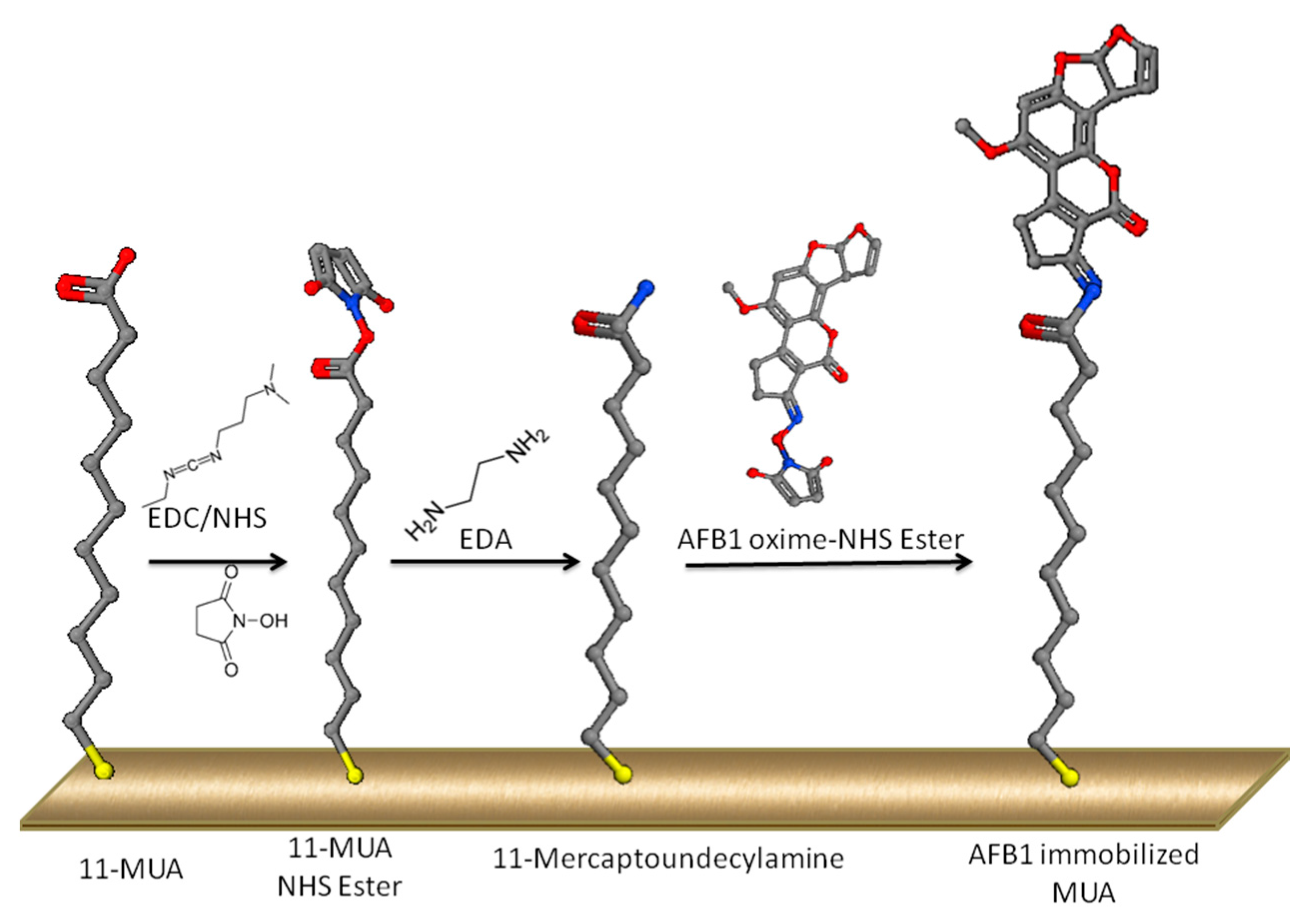
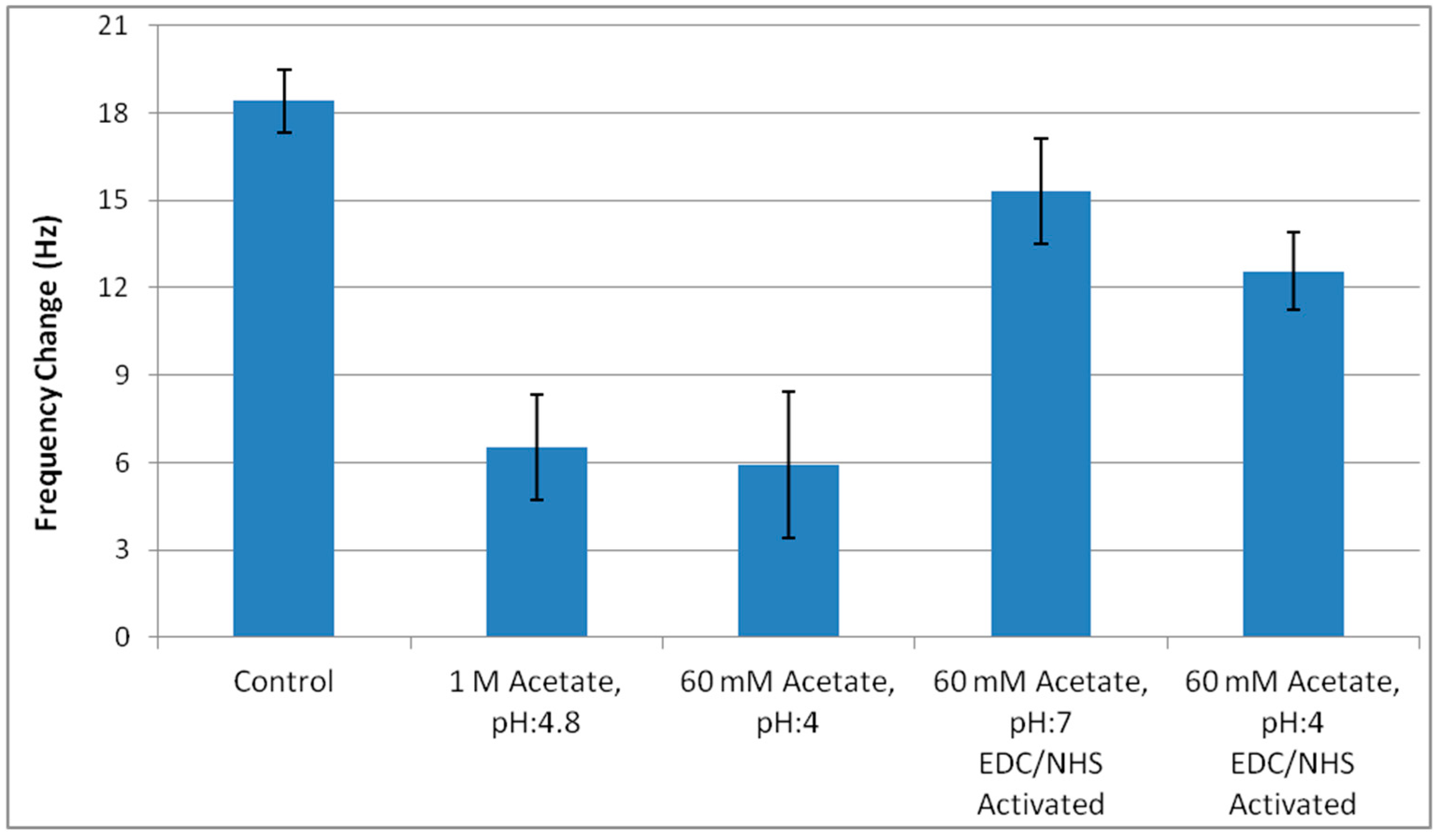
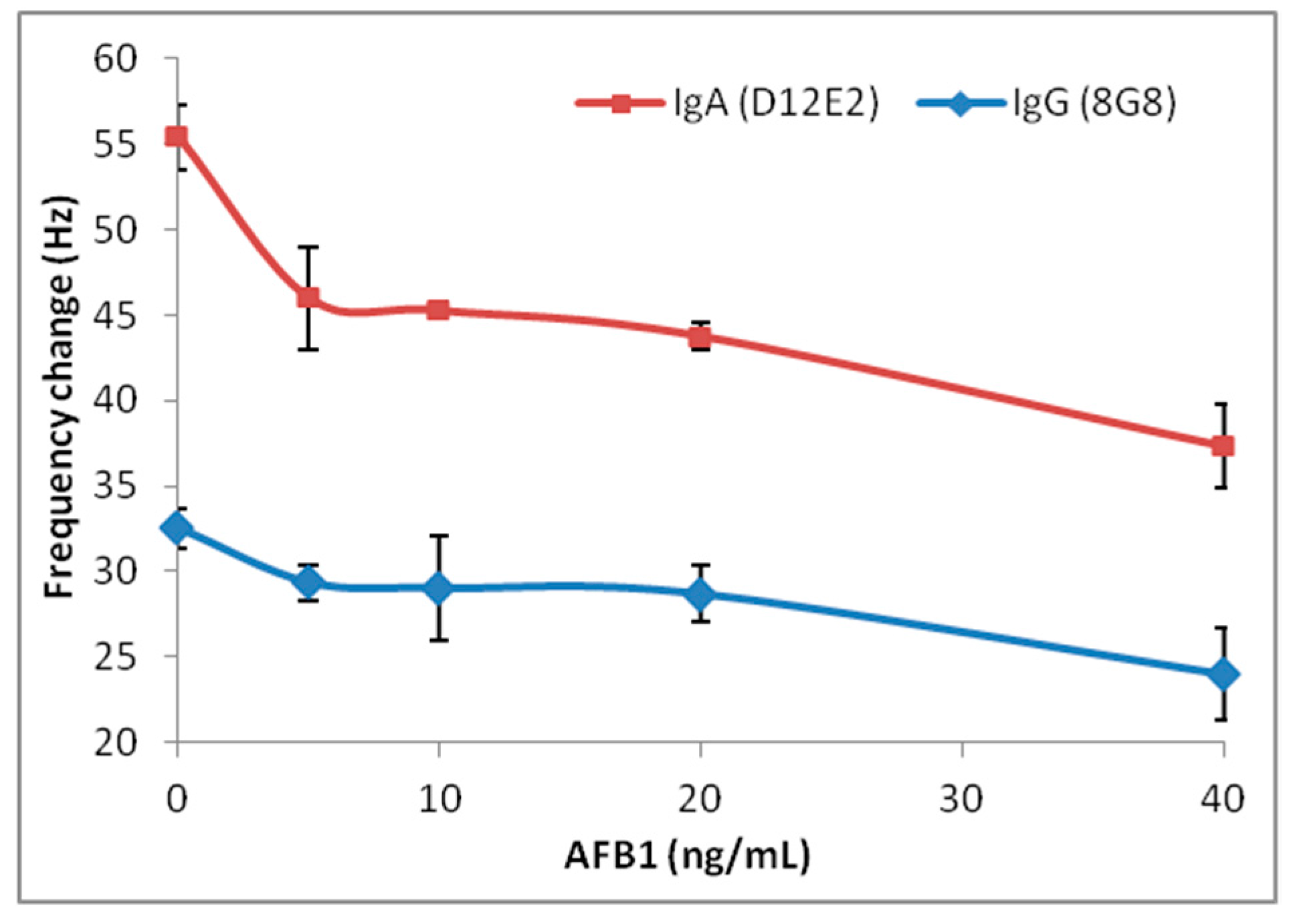
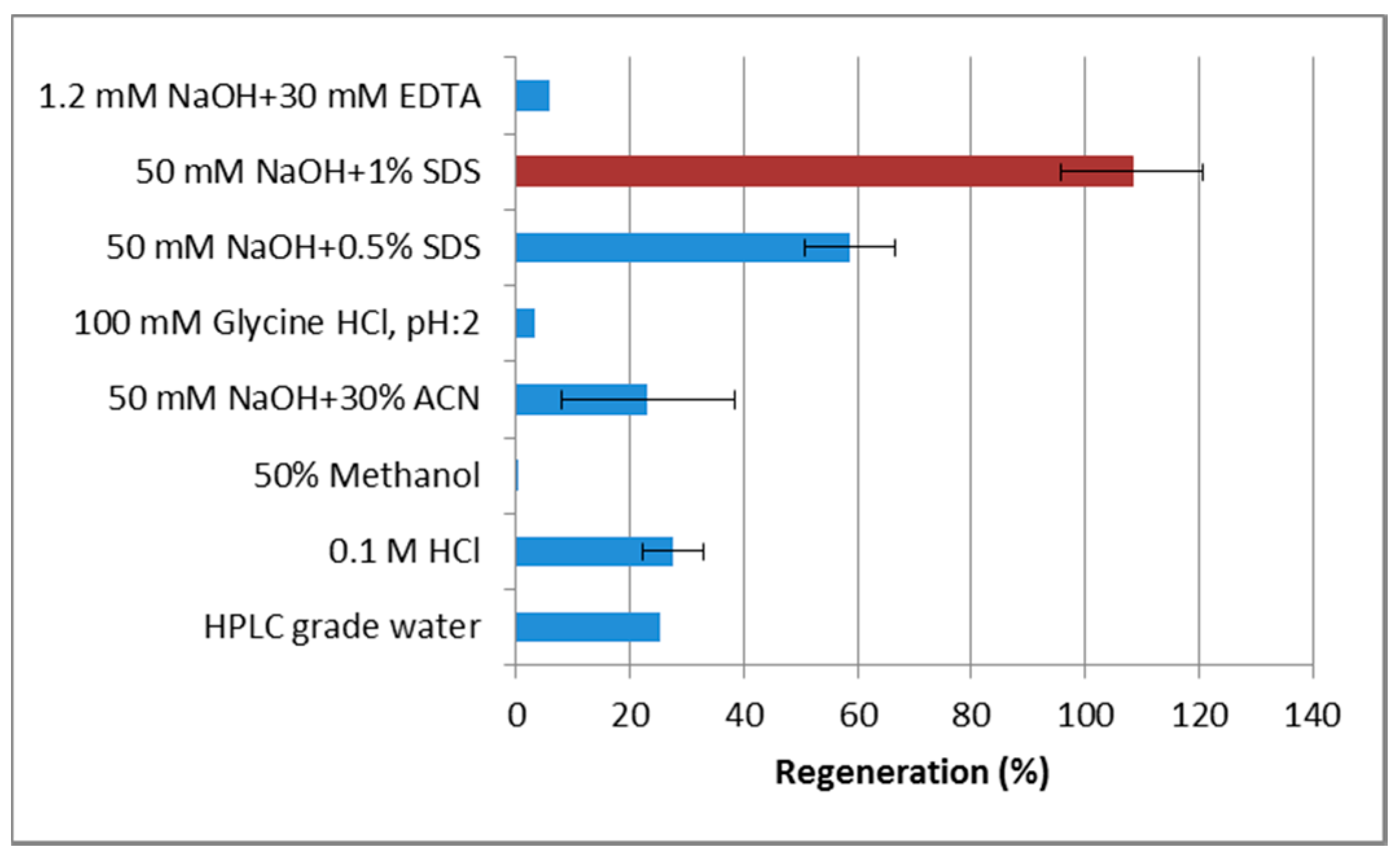

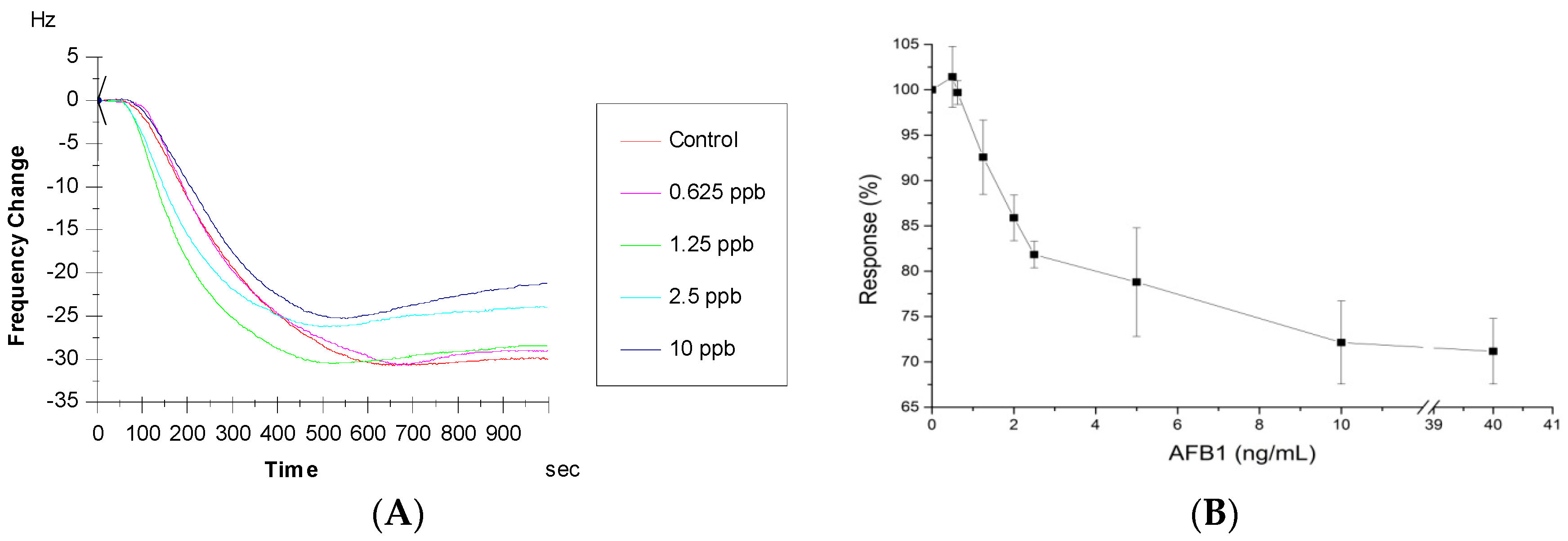
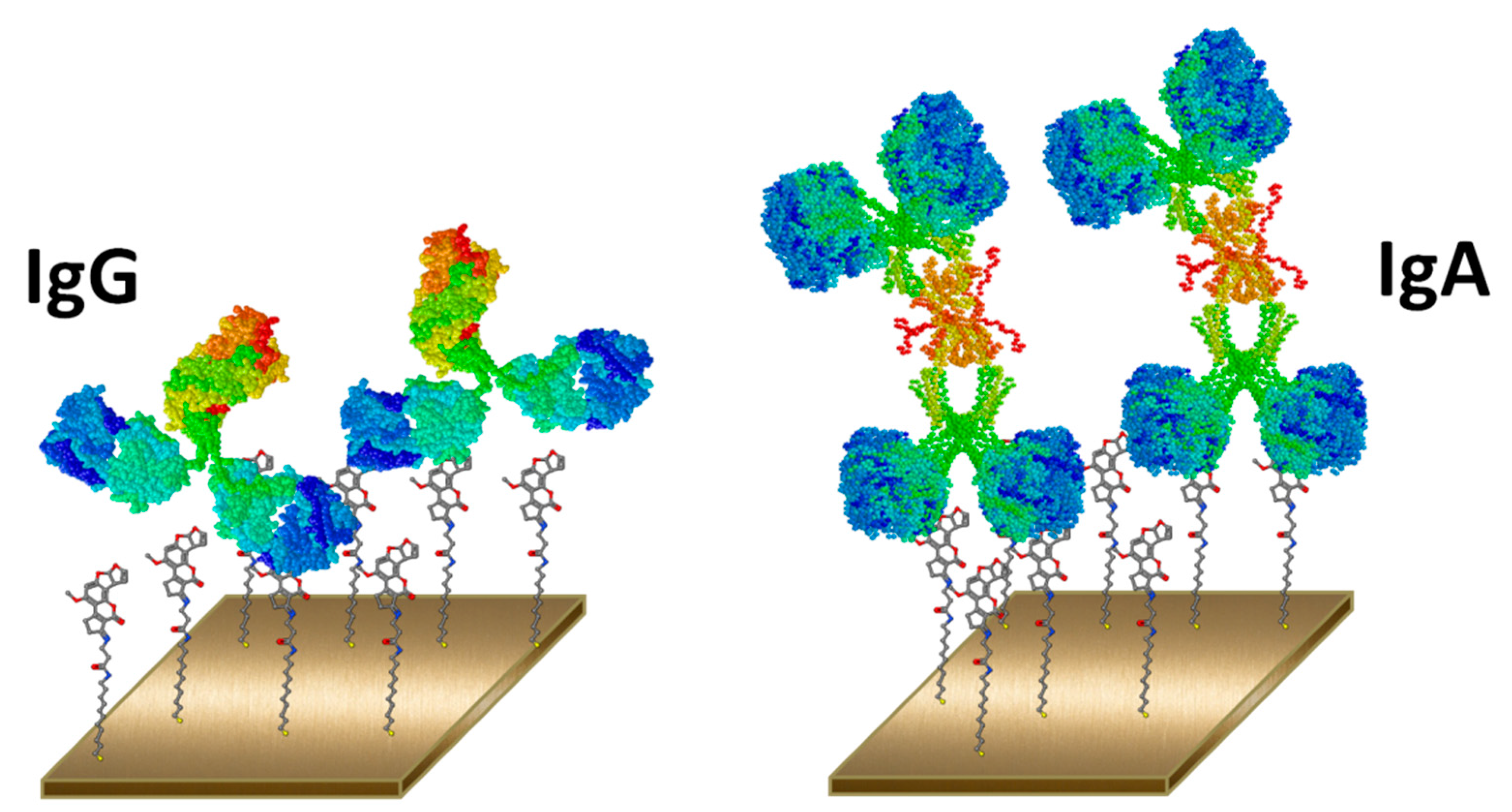
| EDC/NHS Application Time (min) | Frequency Change upon 0.1 mg/mL BSA Application (Hz) |
|---|---|
| 10 | 4.0 ± 1.4 |
| 15 | 9.75 ± 1.8 |
| AFB1 (ng/mL) | MAM-8G8 (0.1 mg/mL) | MAM-D12E2 (0.1 mg/mL) | Fold Difference (MAM-D12E2/MAM-8G8) |
|---|---|---|---|
| 5 | 3.2 Hz | 9.4 Hz | 3.0 |
| 10 | 3.5 Hz | 10.2 Hz | 2.9 |
| 20 | 3.8 Hz | 11.7 Hz | 3.0 |
| 40 | 8.5 Hz | 18.1 Hz | 2.1 |
© 2016 by the authors; licensee MDPI, Basel, Switzerland. This article is an open access article distributed under the terms and conditions of the Creative Commons Attribution (CC-BY) license (http://creativecommons.org/licenses/by/4.0/).
Share and Cite
Ertekin, Ö.; Öztürk, S.; Öztürk, Z.Z. Label Free QCM Immunobiosensor for AFB1 Detection Using Monoclonal IgA Antibody as Recognition Element. Sensors 2016, 16, 1274. https://doi.org/10.3390/s16081274
Ertekin Ö, Öztürk S, Öztürk ZZ. Label Free QCM Immunobiosensor for AFB1 Detection Using Monoclonal IgA Antibody as Recognition Element. Sensors. 2016; 16(8):1274. https://doi.org/10.3390/s16081274
Chicago/Turabian StyleErtekin, Özlem, Selma Öztürk, and Zafer Ziya Öztürk. 2016. "Label Free QCM Immunobiosensor for AFB1 Detection Using Monoclonal IgA Antibody as Recognition Element" Sensors 16, no. 8: 1274. https://doi.org/10.3390/s16081274
APA StyleErtekin, Ö., Öztürk, S., & Öztürk, Z. Z. (2016). Label Free QCM Immunobiosensor for AFB1 Detection Using Monoclonal IgA Antibody as Recognition Element. Sensors, 16(8), 1274. https://doi.org/10.3390/s16081274





